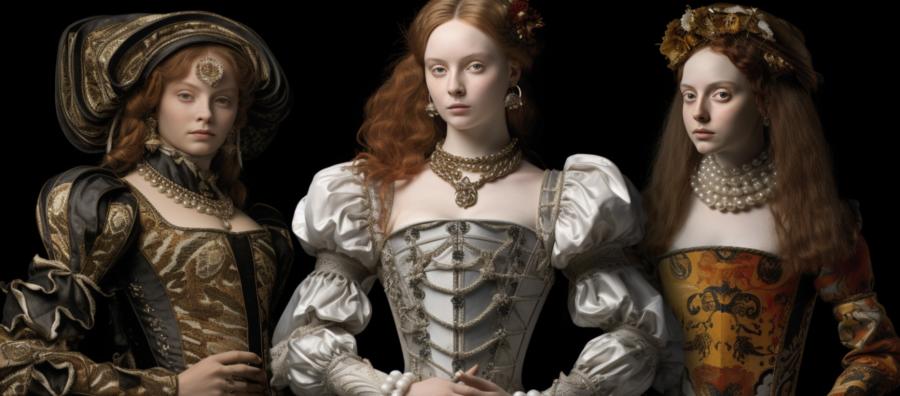Renaissance Ruffs: Florence's 1500s Fashion Statement

Introduction to Florentine Ruffs
Picture this, if you will: the streets of Florence, Italy in the 1500s. The air is alive with the sweet scent of garlic and distant echoes of Leonardo da Vinci humming tunes to himself. There's no denying that the Renaissance was a time of unparalleled creativity and innovation. In addition to the spectacular art and literature, this era also brought us an unforgettable fashion statement: the ruff.What on Earth Is a Ruff?
Now, you may be wondering, just what is a ruff? Well, my fashion-curious friend, a ruff is a large, accordion-like collar, often made of lace or linen. Picture a starched and pleated donut, if you will, encircling the neck of a fashionable Florentine. These extravagant neck accessories graced the necks of fashionable men, women, and even children, and were all the rage in the 1500s.Origins of the Ruff
Like many great things, the ruff has humble beginnings. It started as a simple collar, designed to protect the neck from the elements (and perhaps from stray garlic cloves). Over time, the collar grew in size and complexity, earning its iconic ruffled appearance. The ruff quickly became a status symbol, with the wealthy donning increasingly elaborate and eye-catching ruffs in an attempt to out-ruff the competition.How to Make a Ruffle-worthy Ruff
Creating a ruff is not for the faint of heart. It requires patience, skill, and a fair amount of artistic flair. Here's a quick rundown of the process:- Start by cutting a lengthy strip of fine linen or lace.
- Next comes the pleating. This is achieved by folding the fabric back and forth, accordion-style, while making sure that each fold is perfectly spaced and uniform.
- To ensure that the pleats hold their shape, they must be starched. This involves painting the ruff with a mixture of water and starch, and then allowing it to dry for several hours or even days.
- Once the ruff is dry and sufficiently starched, it can be attached to a neckband which will keep it securely in place around the wearer's neck.
Of course, this is a very simplified version of the process, and creating a ruff worthy of a Renaissance fashionista would likely take a skilled artisan many days to complete. But fear not, for there are many fine ruffs available for purchase in the bustling markets of Florence, should you find yourself in need of a neck accessory.
The Practicality of Ruffs
The ruff may seem like a purely decorative accessory, but it actually served a practical purpose. One could argue that it was the 1500s equivalent of today's turtleneck sweater, providing warmth and protection for the neck. Additionally, ruffs were known to be quite useful in concealing unsightly neck blemishes or love bites from overzealous admirers.Ruffs Through the Ages
As time marched on and fashion evolved, the ruff began to wane in popularity. By the 17th century, the ruff had largely been replaced by other neck adornments, such as lace collars and cravats. However, the ruff has never truly disappeared. It continues to make occasional appearances in fashion, particularly in the realm of high-end couture and theatrical costumes.Ruffs in Popular Culture
Ruffs have left an indelible mark on popular culture, with many famous figures adopting the ruff as their signature accessory. Queen Elizabeth I was known for her love of ruffs, often sporting elaborate versions adorned with pearls and precious stones. William Shakespeare, too, was a fan of the ruff, as evidenced by the numerous ruff-wearing characters in his plays.More recently, ruffs have made a comeback in the world of fashion, appearing on runways and in the pages of fashion magazines. Even Lady Gaga has been spotted wearing a ruff, proving that this Renaissance fashion statement still has the power to turn heads.
Conclusion
The ruff may have had its heyday in the Renaissance, but its bold and distinctive style continues to captivate fashion enthusiasts to this day. Whether you're browsing the shops of Florence or simply looking to add some Renaissance flair to your wardrobe, the ruff remains a unique and unforgettable fashion statement.Article kindly provided by foreverinfashion.org
Latest Articles
- The Psychology of Tattoo Aesthetics: Why Certain Imagery Resonates
- Style That Works With Your Body, Not Against It
- Fashion Tourism on Wheels: Curated Shopping Routes Led by Chauffeur Guides
- The Charm of Certainty in a World of Indecision
- Can an Everyday T-Shirt Be Turned into a Modern Heirloom?
- Color, Ceremony, and the Psychology of Celebration
- Styling Graphic T-Shirts for Different Body Types
- Getting Kids to Wear Their Hats Without a Bribe or a Meltdown
- Mastering the Art of Being the Unnoticed Photographer
- Quiet Sportswear Moves Loudly
- Fashion's Most Misunderstood Color Is Brown
- Weight Matters When Cotton Gets Real
- SKU's Out for Summer: Why Your Warehouse Is Melting Down
- Ink as Accessory - How Tattoos Are Replacing Jewelry in Modern Style
- Accessories
- Jewellery
- Footwear
- Skirts and Dresses
- Shirts and Blouses
- Beauty and Makeup
- Fashion Photography
- Sustainable Fashion
- Street Style
- Fashion History
- Fashion Business
- Fashion Styling
- Fashion Events
- Plus-Size Fashion
- Men's Fashion
- Women's Fashion
- Fashion Blogging
- Fashion Trends
- Fashion Retailers
- Fashion Tips and Advice
- Fashion Business Startups
- Fashion Around the World
- Lingerie
- Sportswear
- Weddings

